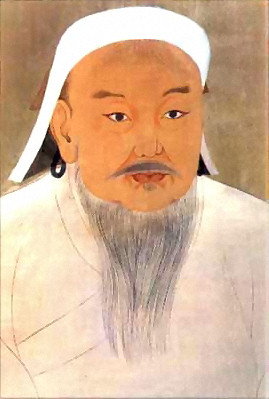Genghis Khan
Genghis Khan (born Temujin 1162 - August 27, 1227) was the founder and Great Khan (emperor) of the Mongol Empire, which became the largest contiguous empire in history after his demise.

|
| “ | The greatest joy for a man is to defeat his enemies, to drive them before him, to take from them all they possess, to see those they love in tears, to ride their horses, and to hold their wives and daughters in his arms. | „ |
| ~ Genghis Khan |
He came to power by uniting many of the nomadic tribes of Mongolia. After founding the Mongol Empire and being proclaimed "Genghis Khan", he started the Mongol invasions that resulted in the conquest of much of Eurasia. These campaigns were often accompanied by wholesale massacres of the civilian populations – especially in the Khwarezmian controlled lands. By the end of his life, the Mongol Empire occupied a substantial portion of Central Asia and China.
Birth and Early Life edit
Genghis Khan was born in northern mongolia in what is said to be 1162. He was born to Yesugei, the chief of the Borjigin clan, and his wife Hoelun. His name when he was born was Temlijun, which means iron. The common legend is that when he was born he was holding a clot of blood in his hand. At age 9, Yesugei took Temlijun to the Ongirrad tribe to marry someone from that tribe. Temlijun was chosen to marry Borte (his future wife). However, after, Yesugei was killed, led to the family of Temlijun was forced into be exile, living off plants and small animals. Soon after, the Tayichiud captured Temlijun and. but Temlijun soon escaped. He then went to marry Borte in 1178. 2 years later, the Merekit tribe captured Borte and raided the camp of Temlijun. Temlijun allied with his fathers friend Toghril to rescue Borte and defeat the Merekit, which they did.
Personality and Appearence edit
to be added
Uniting Mongolia edit
After his campaign against the Merekit, he met an old ally named Jamukha. Both men were allies until Jamukha turned against him. After this, Temlijun convinced the Jin to assist him in defeating the Tatars. Temlijun and Toghril also campaigned and defeated the Merekit remnants, the Naiman's, and the Tayichiud. At a battle with the Tayichud, an arrow struck his neck, which would have killed him if it hadn't been for a man swallowing the rushing blood. The relationship with Toghril deteriorated into a series of battles and raids between the 2 forces until Genghis defeated Toghril in 1203 and Toghril fled to Turkestan. In 1205, Temlijun led a campaign against a Naiman coalition and defeated them at the Altai Mountains. Jamuga, who was part of the coalition, was captured and executed. Temlijun was now the sole ruler of Mongolia, and, was given the name Genghis Khan in a kurultai in 1206
Invasion of China edit
Before invading China, a mongol army was sent in 1207 to conquer the northern tribes which inhabited what is now southern Siberia. In this same year, Genghis invaded the kingdom of Xia Xia located in Central China and forced them to pay tribute. In 1209, the Uighurs which inhabited east Turkestan (Now part of Xinjiang in China) revolted against Qara Khitai and submitted to Genghis Khan. Also in 1209, the Tangut kingdom stopped paying tribute, which led Genghis to invade the kingdom again, reaching all the way to the capital before the Tangut finally submitted and re paid tribute.
After these conquests and protections of his flanks, Genghis invaded the Jin dynasty in 1211. Genghis split up his army into 2 parts, and the parts of the army moved to outflank the Jin by bypassing the Great Wall. The Jin army were quickly defeated and Genghis advanced into China before returning back into Mongolia in winter. In 1212, the Mongols under Jebe conquered the city of Liaoyang in Manchuria, and the sons of Genghis Khan raided into what is now Shaanxi province. The Khitans of Manchuria under the command of Yelu Ahai revolted in Manchuria defeating the Jin, expelling them from Manchuria. The rest of 1212 was spent raiding Shaanxi and Shanxi province. In 1213 and 1241, the Mongols raided much of Jin China, including Shandong, Hebei, Shanxi province, and the Liaodong peninsula. Due to the raids, the Jin emperor decided to accept a truce which the terms of the treaty favoured the Mongols. However, after this treaty, the Jin moved their capital from Beijing to Kaifeng further south to flee the Mongol army. When Genghis heard of this move, he decided to besiege Beijing in 1215. Genghis captured the towns surrounding Beijing
Conquest of Central Asia edit
to be added
Mongol Millitary edit
to be added
Final invasion and Death edit
to be added
Trivia edit
- According to Watchmojo's 10 Most EVIL Men in History video, Genghis Khan is the fifth most evil man in the history of mankind.
